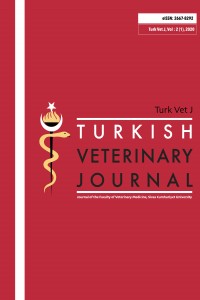Review
Year 2020,
Volume: 2 Issue: 1, 24 - 28, 13.07.2020
Abstract
Günümüz veteriner hekimliğinde, yara tedavileri klasik görüşlerin dışında artık yeni teknolojik ürünlerin de dahil edilmesiyle boyutlarını değiştirmiştir. Bunun yanında bal gibi bazı kadim preparatların faydaları ve diğer bazı ilaçlara olan üstünlükleri yeniden tartışılmaya başlanmıştır. Bu derlemeyle açık yara tedavisinde kullanılan tedavi yöntemlerini ve preparatları bir araya toplamaya çalıştık. Amacımız bunların ülkemizde de aktif bir şekilde kullanılmaya başlanması ve açık yara tedavisinin iyileştirilmesidir.
References
- 1. Dyson M (1997) Advances in wound healing physiology: the comparative perspective (Avances en fisiologia de la curación de heridas: perspectiva). Veterinary Dermatology 8: 227–233.
- 2. Pavletic MM (2010) Basic principles of wound management. In: Pavletic MM (ed): Atlas of small animal wound management and reconstructive surgery, 4th edition. Wiley-Blackwell, Massachussetts. pp: 33-53.
- 3. Cornell K (2012) Wound healing. In: Tobias KM, Johnston SA (ed) Veterinary surgery small animal, 1st edition. Elsevier- Saunders, Missouri. pp: 125-135.
- 4. Çelimli N (2004) Wound management using honey in veterinary practice. Veteriner Cerrahi Dergisi 10 (3-4), 73-77.
- 5. Chirife J, Scarmato GA, Herszage L (1982) Scientific basis for use of granulated sugar in treatment of infected wounds. Lanced 1: 560-561.
- 6. Yavru N, Koç Y, Arıcan M, Doğruer Y (1992) The effect of granulated sugar application on healing in the treatment of infected wounds and abscesses, SU Vet Fak Derg 8: 1: 64-68.
- 7. MacPhail CM (2013) Biomaterials, suturing and hemostasis. In: Fossum TW (ed) Small animal surgery, 4th edition. Elsevier, Philadelphia, PA. pp: 64-84.
- 8. Selçukbiricik H, Hayat A, Eraslan H, Tursun G (2004) Management of chronic wound in a dog with tissupor wound pad: Case report. YYÜ Vet Fak Derg 15 (1-2): 75-77.
- 9. Williams JM (1999) Open wound management. In: Fowler D, Williams JM (ed) BSAVA Manual of canine and feline wound management and reconstruction, 1st edition. BSAVA, Cheltenham, UK. pp: 37-47.
- 10. Preifke MB, Jayasuriya AA, Jayasuriya AC (2015) Current wound healing procedures and potential care. Materials Science and Engineering C 48: 651-662.
- 11. Mathews KA, Binnington AG (2002) Wound management using honey. Compendium on Continuing Education for the Practising Veterinarian -North American Edition- 24: 1: 53-60.
- 12. Molon P, Rhodes T (2015) Honey: A biologic wound dressing. Wounds: 27(6): 141-151.
- 13. Liptak JM (1997) An overview of the topical management of wounds. Aust Vet J 75: 6: 408-413.
- 14. Anderson D (1996) Wound management in small snimal practice. Companion Animal Practice 18 (3): 115-128.
- 15. Vowden K, Vowden P (2017) Wound dressings: principles and practice. Surgery (Oxford) 35: 9: 489-494.
- 16. Singh S, Young A, McNaught CE (2017) The physiology of wound healing. Surgery (Oxford) 35: 9: 473-477.
- 17. Dernell WS (2006) Initial wound management. Vet Clin Small Anim 36: 713-738.
- 18. Akkan HA, Karaca M (2003) Veteriner iç hastalıklarında antibiyotiklerin kullanımı. YYU Vet Fak Derg 14 (2): 72-77. 19. Güzel Ö, Yıldar E, Erdikmen DO (2011) Medikal ozon ve veteriner cerrahide kullanımı. IU Vet Fak Derg 37 (2): 177-184.
There are 18 citations in total.
Details
| Primary Language | Turkish |
|---|---|
| Subjects | Veterinary Surgery |
| Journal Section | Review |
| Authors | |
| Publication Date | July 13, 2020 |
| Published in Issue | Year 2020 Volume: 2 Issue: 1 |

